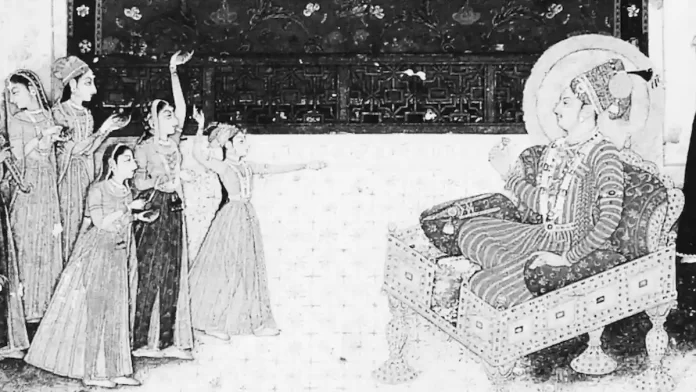Rajput history is often portrayed as a tapestry woven with tales of valor, royalty, and sacrificial traditions.
However, one lesser known but equally fascinating aspects of Rajput history is the practice of harem, which were also an integral part of the lives of the leading Rajput ruling clans.
Harems were spaces where women, both enslaved and concubines, resided under the care of their Rajput conquerors.
These harems, however, were not confined to Rajput society alone but were found across various communities of northern India.
In this article, we delve into the intriguing world of Rajput harems, exploring their practices, implications, and the complexities surrounding historical documentation.
Polygamy and Enslavement: The Dual Faces of Rajput Harems
Historically, polygamy was not uncommon among Rajput rulers. Alongside their wives, they also took women enslaved during battles as concubines.
Captives from numerous armed conflicts in India were taken, enslaved, and sold to Rajputs and non-Rajputs alike.
An example of this occurred during the battle between Jaipur state and Jodhpur state in 1807 when Marwar’s women were captured and sold by Jaipur’s forces.
According to Priyanka Khanna, with Marwar’s royal Rajput households, the women who underwent concubinage also included women from the Gujar, Ahir, Jat, Mali, Kayastha, and Darji communities of that region.
These castes of Marwar claimed Rajput descent based on the census data of Marwar, 1861.
Within these harems, women were assigned various roles, each with its distinct name.
A “domestic slave” was referred to as davri, a dancer as a patar, a “senior female slave–retainer in the women’s quarters” as badaran or vadaran, a concubine as khavasin, and a woman permitted to wear the veil akin to Rajput queens as a pardayat.
The term “chakar” was used for individuals serving their superiors, and these chakras often included complete families from specific occupational groups such as Brahmin women, cooks, nurses, tailors, and washerwomen.
Children born from the “illegitimate unions” between Rajputs and their “inferiors” were labeled as goli and darogi for females and gola and daroga for males.
Complex Dynamics: Rajput Conquerors and Captured Women
According to historical accounts, women perceived to be of “higher social rank” were sometimes assigned to the harems of their conquerors, either with or without marriage.
Interestingly, Rajput courtly chronicles also document instances of women from the Rajput community facing similar treatment from the winning side of a battle.
For instance, Rajput women could be incorporated into Mughal Harem and this defined the Mughals as overlords over the Rajput clans.
The Sisodia clan of Mewar was an exception as they refused to send their women to the Mughal Harem which resulted in siege and mass suicide at Chittor.
There are also a number of records between the late 16th to mid–19th century of the Rajputs immolating the queens, servants, and slaves of a king upon his death.
Ramya Sreenivasan also gives an example of a Jain concubine who went from being a servant to a superior concubine called Paswan.
The dynamics within these harems were far from simple and showcased the intricacies of power, status, and relationships.
Modern scholars attempting to study the forms of slavery and servitude imposed on captured women by the ruling clans of Rajasthan between the 16th and early–19th centuries face considerable hurdles.
Sparse information, uneven record-keeping, and biased nature of historical records make it difficult to gain a complete understanding of the lives of these women and the intricacies of the harem system.
Intermingling of Lineages and Communities
In some cases, male children born from these unions were identified by their father’s names and were even considered as ‘dhaibhai’ or foster-brothers to their half-siblings.
They were sometimes incorporated into the Rajput households and actively participated in war campaigns, showcasing the complex familial ties within the harems.
Female children born to concubines and slaves faced different fates. Some married Rajput men in exchange for money, while others ended up becoming dancing girls.
The issue of female infanticide led to the kidnapping of low-caste women, who were then sold to higher-clan Rajputs as brides.
These marriages were considered legal as they were genuinely for matrimony purposes.
Semi-nomadic communities like Jats, Ahir and Gujjars also played a role in these dynamics, marrying their daughters to Rajput bridegrooms for financial reasons.
Such intermingling of lineages and communities adds another layer of complexity to the history of Rajput harems.
Beyond Rajputs: Similar Practices Across Communities
It is essential to understand that the mistreatment or enslavement of women was not unique to Rajput society.
Historical observations note that other communities, such as Khatris and Kayasthas, also practiced similar customs and openly kept women slaves from various tribes.
The descendants of these women often formed matrimonial groups, highlighting the interwoven histories of various communities.
Conclusion
The history of Rajput harems presents us with a complex tapestry of power, politics, and societal norms.
These harems were not just spaces of captivity; they encompassed an intricate web of relationships, with women from different backgrounds finding themselves enmeshed in the lives of Rajput rulers.
Despite the challenges in understanding this historical aspect, the study of Rajput harems offers us a glimpse into the multifaceted nature of human societies, their customs, and the impact of historical events on marginalized communities.
As we explore these hidden chapters of history, we must remember the lessons they teach us about the significance of accurate and unbiased historical documentation, ensuring that the voices of the past echo into the future.
Sources–
- History of Medieval India (Satish Chandra)
- Drudges, Dancing Girls, Concubines: Female Slaves in Rajput Polity (Ramya Sreenivasan)
- Embodying Royal Concubinage: Some Aspects of Concubinage in Royal Rajput Household of Marwar (Priyanka Khanna)
- Constitutional Development of Eastern Rajputana States (DD Gaur)
